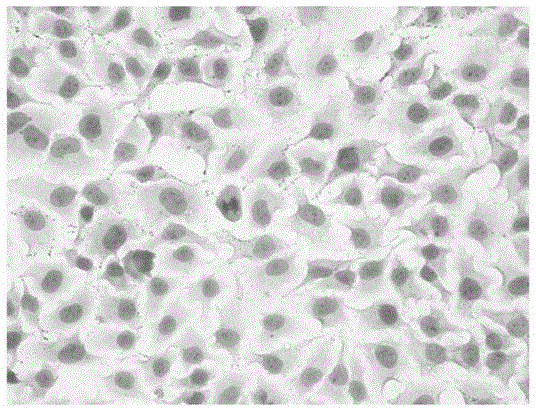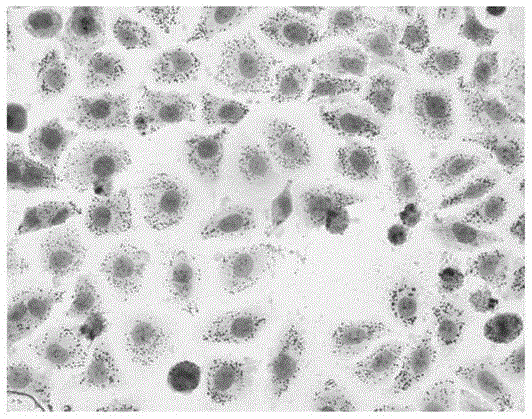Enzymatically decomposed clam oligopeptide having recovery effect on non-alcoholic fatty liver disease cell model and preparation method of calm oligopeptide
A fatty liver disease and cell model technology, applied in the direction of biochemical equipment and methods, peptide, microorganism measurement/inspection, etc., can solve the problems of poor effect and lack of specific methods for conservative treatment, so as to reduce the degree of damage and clear cells The ability of oxygen free radicals is enhanced, and the modeling method is simple and easy to implement
- Summary
- Abstract
- Description
- Claims
- Application Information
AI Technical Summary
Problems solved by technology
Method used
Image
Examples
Embodiment 1
[0024] 1. Establishment of NAFLD model
[0025] Normal liver Chang liver cells (hereinafter referred to as normal group cells) were cultured in DMEM culture medium, 37°C, 5% CO2 incubator, and the culture medium was discarded after the cells adhered to 80%, digested with 0.25% trypsin, and passaged to cultivate. Select cells with good growth status, induce Chang liver cells with 15 μg / mL palmitic acid, collect cells after treatment for 12h, 24h, 48h, and 72h, and measure triglyceride (TG) content. The TG detection method follows the kit instructions conduct. The induction time was selected so that the TG content of normal liver Chang liver cells increased significantly and the cells grew well, and an in vitro NAFLD cell model (hereinafter referred to as model group cells) was established.
[0026] The TG content of normal liver Chang liver cells induced by 15 μg / mL palmitic acid showed that the TG content increased significantly after the treatment with palmitic acid, but af...
Embodiment 2
[0047] Example 2 The oligopeptide obtained by enzymolysis of clams with alkaline protease has obvious repairing effect on NAFLD cell model
[0048] Inoculate the cells of the normal group and the model group on the cover glass in the six-well culture plate, discard the nutrient solution after 24 hours and divide them into three groups of cells, namely, the cells of the normal group, the cells of the model group and the clam hydrolyzate prepared in Example 1 The cells in the model group (hereinafter referred to as the drug group) under the action were routinely cultured in the normal group and the model group, and the cells in the drug group were treated with a drug concentration of 10 mg / mL, and the experiment was ended after 24 hours of culture. Fix the cells with 10% neutral formaldehyde for 10 minutes, incubate with oil red O staining solution for 15 minutes, discard the staining solution, wash with PBS, wash with PBS after hematoxylin staining for 5 minutes, and observe red...
Embodiment 3
[0050] Embodiment 3 Determination of liver cell function index
[0051] Alanine aminotransferase (ALT), aspartate aminotransferase (AST), malondialdehyde (MDA), glutathione S-transferase (GSH-ST), γ-glutamyltransferase (GSH-ST), and The content of aminoacyltranspeptidase (γ-GT), superoxide dismutase (SOD) and other indicators, the detection method is carried out according to the kit instructions. Among them, the test results of liver cell function indicators are shown in Table 6. It can be seen that the contents of MDA, GSH-ST, ALT, AST, and γ-GT in the model group were significantly higher than those in the normal group, and the levels of the drug group after being treated with clam oligopeptides decreased significantly. , which was statistically significant compared with the model group (P<0.05). The content of SOD decreased in the model group and increased in the drug group, but there was no statistical significance compared with the model group. ALT mainly exists in the ...
PUM
 Login to View More
Login to View More Abstract
Description
Claims
Application Information
 Login to View More
Login to View More - R&D
- Intellectual Property
- Life Sciences
- Materials
- Tech Scout
- Unparalleled Data Quality
- Higher Quality Content
- 60% Fewer Hallucinations
Browse by: Latest US Patents, China's latest patents, Technical Efficacy Thesaurus, Application Domain, Technology Topic, Popular Technical Reports.
© 2025 PatSnap. All rights reserved.Legal|Privacy policy|Modern Slavery Act Transparency Statement|Sitemap|About US| Contact US: help@patsnap.com



